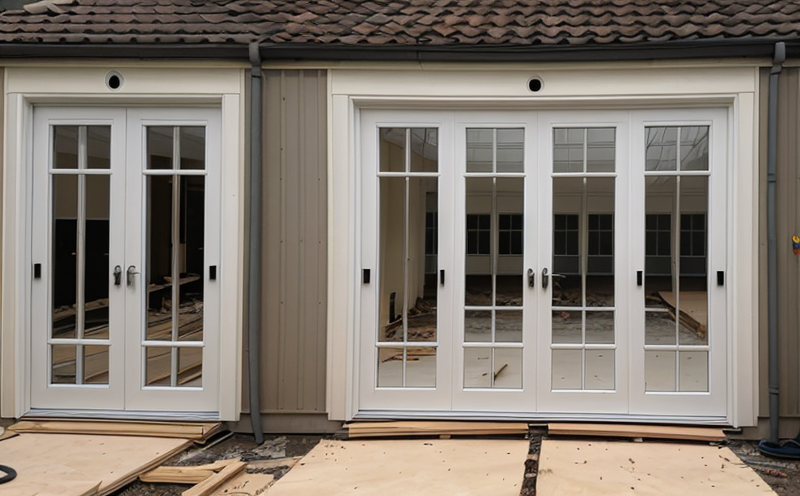BS 476-20 Fire Tests on Building Materials – Doors Focus
The British Standard BS 476 series is one of the most stringent and widely recognized standards in fire safety testing. Specifically, BS 476-20 provides comprehensive guidelines for determining the resistance to ignition, flame spread, and structural integrity of building materials under various fire conditions. This section focuses on fire tests conducted according to this standard, particularly as they relate to doors.
Doors are critical components in any fire safety design. They must not only resist fire but also maintain their structural integrity until the occupants can safely evacuate a building. BS 476-20 mandates rigorous testing protocols that ensure materials used for doors meet strict criteria, which is essential for public and commercial buildings.
The standard defines various types of doors subjected to different fire scenarios, including the duration of exposure to fire (typically between 30 minutes up to several hours). During these tests, engineers measure the rate at which flames spread across the door surface, the temperature rise on the non-fire side, and whether or not there is any structural collapse.
One key aspect of BS 476-20 testing involves understanding how doors behave under intense heat. The test chamber simulates real-world conditions by using propane burners that generate flames at temperatures exceeding 1,000°C (about 1,832°F). This allows for a precise evaluation of the door's performance in containing fire and preventing its spread throughout the building.
Another crucial factor is ensuring doors retain their structural integrity. This means they must remain closed and intact during extended periods of exposure to high temperatures. Structural tests often involve applying pressure to simulate wind loads or other forces that could cause doors to open under fire conditions, thereby compromising safety.
Fire testing also includes assessing the door's ability to withstand smoke and toxic gases produced by the fire. This is particularly important for ensuring safe evacuation routes remain clear and breathable even as fires burn inside buildings.
In summary, BS 476-20 provides a robust framework for evaluating doors' performance in resisting ignition, flame spread, and maintaining structural integrity during severe fire events. Compliance with these standards ensures that construction materials used in doors meet stringent safety requirements critical to protecting lives and property.
Applied Standards
| Standard | Description |
|---|---|
| BS 476-20:1985 | This standard specifies methods of test for determining the fire resistance of building materials and products. |
| EN 1363:2005 | A European standard providing supplementary information on the application of BS 476-20, focusing specifically on doors. |
| ASTM E136/E136M-20a | An American standard that complements BS 476 by offering additional testing procedures relevant to fire resistance. |
Eurolab Advantages
At Eurolab, we pride ourselves on delivering exceptional fire safety testing services aligned with international standards like BS 476-20. Our state-of-the-art facilities equipped with advanced instrumentation ensure accurate and reliable results.
We employ highly skilled engineers who possess extensive experience in conducting complex fire tests, ensuring that every sample is prepared meticulously before undergoing rigorous examination. Our team stays updated on the latest developments within the industry to provide clients with cutting-edge solutions tailored specifically for their needs.
Our commitment extends beyond just meeting regulatory requirements; we strive to go above and beyond expectations by offering comprehensive support throughout the entire testing process, from initial consultation through final report delivery. This includes providing detailed feedback during each step of the procedure so that our customers fully understand what is happening at every stage.
We also offer flexible scheduling options designed around client schedules rather than fixed calendar dates, allowing businesses to keep their operations running smoothly without disruption. Additionally, our transparent communication ensures there are no misunderstandings regarding test outcomes or next steps required after receiving results.
Why Choose This Test
- Compliance with international standards such as BS 476-20 ensures that your products meet stringent safety requirements, enhancing credibility and marketability.
- Our experienced staff guarantees accurate testing using modern equipment to deliver precise results every time.
- We provide ongoing support throughout the entire process, ensuring clear communication about expectations, progress, and final outcomes.
- Achieve peace of mind knowing that your products have been rigorously tested according to recognized international standards.
- Gain competitive advantage by demonstrating compliance with top-tier quality benchmarks.
- Benefit from our expertise in interpreting test results accurately for informed decision-making.





